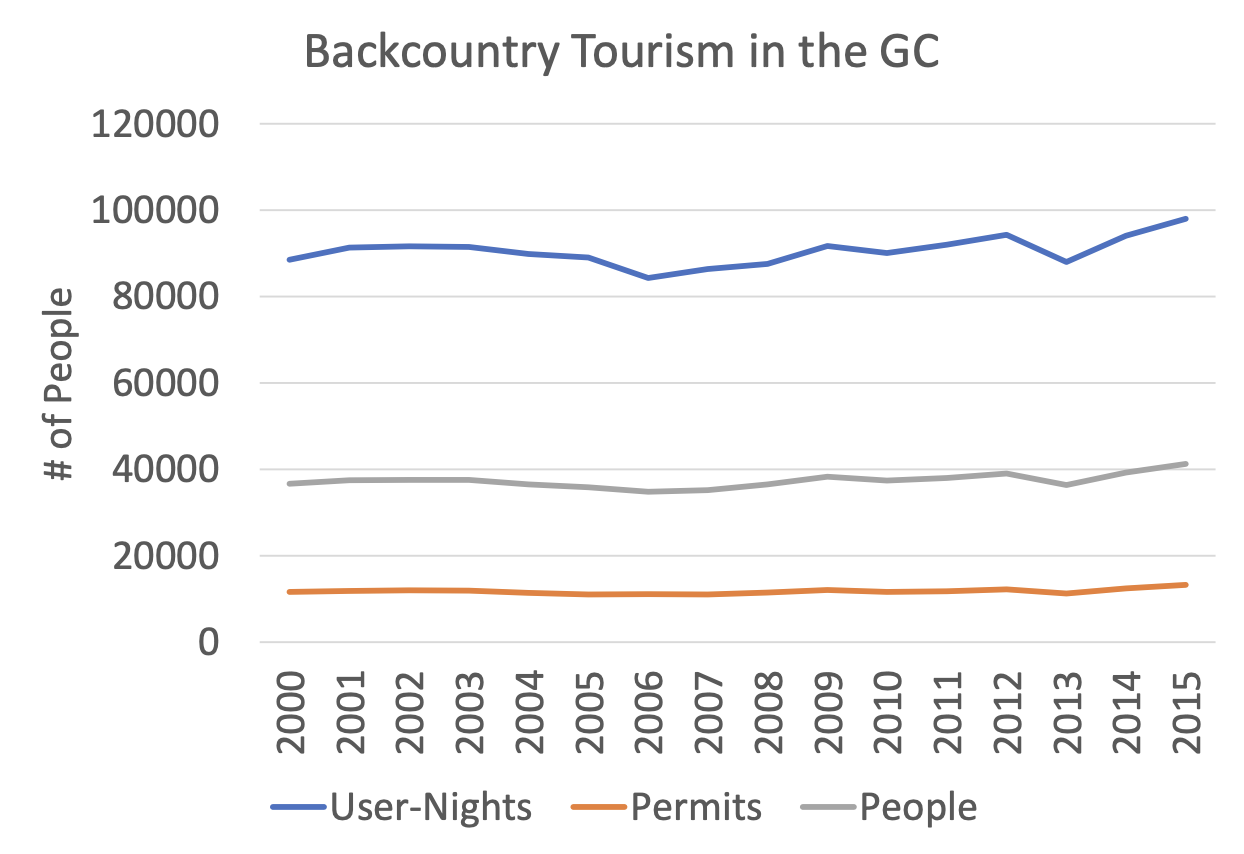Over 6 million visitors traveled to see the stunning views and unique terrain of the Grand Canyon in 2016.[1] Since it’s official opening as a national park in 1919, the park has received more than 200 million visitors and numbers have been steadily increasing since 2011.[2] Aside from its awe-inspiring size, the Grand Canyon is home to an impressive diversity of geologic strata with rocks dating back to around 2 billion years ago, a variety of land features (high plateaus, plains, deserts, forests, cinder cones, lava flows, waterfalls), numerous fish, wildlife and plant species and one of the most prominent whitewater rivers in the United States.[3]
As our class prepares for two weeks of pure bliss rafting through the Grand Canyon, I can’t help but wonder if the Grand Canyon’s annual number of visitors can be sustained while still preserving the beloved features of the landscape. Do we have a responsibility as visitors to mitigate the impacts of our presence in the Grand Canyon? How can we proactively help to preserve the natural features of the Grand Canyon for wildlife, fish and other visitors? How can we support the National Park Service in this effort?
The first step to answering these questions is to better understand visitor impacts on the Grand Canyon National Park overall. These impacts can be organized into 3 main areas: Consumptive, Ecological and Community. Annual consumptive impacts include water use (146 million gallons) and wastewater use, trash (16,541 tons) and greenhouse gases to due travel to the park and energy use within the park (14.6 million kilowatt hours).[4] Ecological impacts center around the act of visiting relatively undisturbed natural areas and disturbing local fauna and flora. The Grand Canyon boosts 89 species of mammals, 355 species of birds, 17 species of fish, 50 species of reptiles, 9 specifics of amphibians and over 1,500 species of plants.[5] Park visitors are essentially entering these species “homes” and although visitors aren’t allowed to feed animals and littering is not allowed anywhere in the park, policies cannot control for all ecological impacts (ex: soil disturbances). Lastly impacts on neighboring and nearby communities have seen increased air pollution and traffic from visitor car travel and increased noise pollution as a result.[6]
The good news is that the National Park Service recognizes these negative impacts and has already been implementing programs to conserve water, increase recycling and reduce greenhouse gases. To conserve water, certain areas in the park reuse wastewater for non-potable uses such as irrigation and toilets. To increase nutrient recycling, a compost program is in place to reuse mule waste. Additionally, bottle refilling stations were installed along with the sale of reusable water bottles that replaced the sale and disposal of single use plastic water bottles, thereby, reducing the need to recycle in the first place. To reduce greenhouse gas emissions, the Grand Canyon Visitor Center has gone solar and now offsets 30% of the building’s electricity through use of 84 photovoltaic cells. Lastly, alternative fuels like natural gas are used for park buses.[7] However, preserving the natural integrity of the Grand Canyon should not only be on the shoulders of the National Park Service. All visitors should consider their own actions as part of the solution! Below are the top 5 actions you can do as a visitor to honor the Grand Canyon’s natural beauty.[8]
- Research before you go. Learn about the Grand Canyon’s ecosystems and history before you go on your trip. Understanding why the Grand Canyon is such a special place can make you more invested in protecting it.
- Consider taking public transit to the Grand Canyon. There are trains available from nearby cities like Las Vegas and Phoenix that take you right into Grand Canyon National Park.[9] You get to avoid traffic, sit back, relax, enjoy the views and save energy all at the same time.
- Carpool with friends if you’re driving. Saves money and it’s more fun too. Additional tip: keep your car tuned up and tires inflated for better gas mileage.
- Travel light. Consider backpacking instead of staying in hotels or resorts. The inherent nature of backpacking (carrying all your supplies on your back) lends itself to bringing and using less resources. Figure 1 shows the increase in backpacking visitors since 2013.[10]
- Reduce your food waste. Everyone has to eat but be mindful of how much food you bring and minimize what gets thrown away. Go ahead eat that second helping of potatoes.
As for our class, we’re focusing on the last tip. We’ll be measuring our food waste throughout our trip and recording it (Table 1). At the end of the trip, we’ll evaluate our food waste and evaluate ways to reduce waste on future trips. While there are many human activities that influence and impact the natural landscape of the Grand Canyon (dams, agriculture, drought, flooding), participating in tourism is one human activity that can be more controlled at the individual level. Brainstorming ideas on how to reduce your own impact can be empowering and set an example for others around you. “We abuse land because we regard it as a commodity belonging to us. When we see land as a community to which we belong, we may begin to use it with love and respect.” Aldo Leopold, A Sand County Almanac.

References
- https://www.nps.gov/grca/learn/news/6-millionth-visitor-2016.htm
- https://www.nps.gov/nr/travel/worldheritagesites/Grand_Canyon_National_Park.htm
- http://landsward.nau.edu/document_forms/SustainabilityAssessment.pdf
- https://www.nps.gov/grca/learn/nature/wildlife.htm
- https://persestudio.org/2015/06/29/what-effect-does-tourism-have-on-the-grand-canyon/
- https://www.nature.nps.gov/parkscience/Archive/PDF/Article_PDFs/ParkScience29(1)SpringSummer2012_48- 52_LeeReeder_2872.pdf
- https://www.nps.gov/grca/learn/nature/the-greening-of-grand-canyon.htm
- https://www.nps.gov/grca/planyourvisit/traveling-green.htm
- https://www.thetrain.com/
- https://www.nps.gov/grca/planyourvisit/upload/BC_Statistics_2015.pdf
